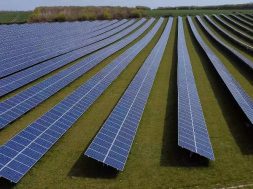
Breakthrough perovskite thin film solar cell patents granted by the US Patent Office to Solar-Tectic LLC
The patents, US 9,978,532 “Maximizing the Power Conversion Efficiency of a Tin Perovskite/Silicon Thin-Film Tandem Solar Cell” and US ser. 15/157,539 “Methods of Growing Heteroepitaxial Single Crystal or Large Grained Semiconductor Films and Devices Thereon” are part of a “Tandem Series” of high efficiency and cost effective solar cell technologies by Solar-Tectic LLC with the potential to surpass the efficiencies of current thin-film solar cell technologies such as CdTe, CIGS, and a-Si, as well as the silicon technology which dominates the global market today based on poly and monocrystalline wafers.
BRIARCLIFF MANOR, N.Y.,: Solar-Tectic LLC (“ST”) announced today that two patent applications for perovskite thin film solar cells have been allowed by the US Patent and Trademark Office (USPTO). One patent covers all kinds of perovskites. The inventors are Ashok Chaudhari, Founding Manager of Solar-Tectic, and the late Dr. Praveen Chaudhari, renowned materials physicist.
Recently perovskite materials have gained much attention as a promising solution to the long-standing problem of solar cell efficiency, which is of primary importance in today’s solar panel market. And while there have been numerous reports of perovskite/silicon (wafer) tandem solar cells (and extensive intellectual property) remarkably there has been none on a perovskite/crystalline silicon thin-film tandem solar cell, until Solar-Tectic LLC’s breakthrough publication (http://www.nscj.co.uk/JECM/PDF/3-2-2-Chaudhari.pdf). Wafer sized bottom poly- and monocrystalline silicon layers in PERC, PERL, HIT, HJ, or perovskite/silicon tandem cells are typically 200-280 microns thick, whereas ST’s thin-film crystalline inorganic bottom layers can be as thin as 20-30 microns with the same or similar efficiency; moreover, they can be processed at much lower temperatures thereby lowering costs of production significantly. The top perovskite layer is less than only 1 micron – an ultra-thin film — and a thin film crystalline silicon (CSiTF) bottom layer decouples the need for a silicon wafer. If the price of polysilicon rises less silicon material use will be an additional cost savings.
Tandem perovskite solar cells are capable in theory of 45% efficiency, though ST has set a more realistic 30% efficiency goal, higher than the best silicon wafer technologies such as PERC, PERL, HIT, HJ cells with 25-26.6% efficiencies. The efficiencies of today’s solar cells on the market in general range from 14% – 25%. A cost effective 30% efficient solar cell with a simple design would revolutionize the solar energy industry by dramatically reducing the balance of system (BoS) costs, thereby lessening the need for fossil fuel generated electricity significantly. Silicon wafer technology based on polycrystalline or monocrystalline silicon, which is 90% of today’s market, would become obsolete.
Importantly, the entire ST process is environmentally friendly since non-toxic Sn (tin) or Au (gold) is used to deposit the crystalline silicon thin-film material for the bottom layer in the tandem/heterojunction configuration as well as in the top, perovskite, layer. The more commonly used toxic Pb (lead) is not used in the perovskite here. The manufacturing methods used in this technology – sputtering or electron beam evaporation — are conventional and similar to those used in today’s thin-film solar cell industry, and importantly also in the display industry with which there is much overlap and potential for synergy.
The breakthrough patents correspond to a “Tandem Series” of solar cell technologies which has been launched by ST, and that includes a variety of different proven semiconductor photovoltaic materials (i.e. III-V, CZTS, a-Si, etc) for the top layer on silicon (or germanium) bottom layer, on various substrates such as cheap soda-lime glass. A paper reporting a successful step in this approach was recently published (https://www.sciencedirect.com/science/article/pii/S0167577X18302945). Last year, ST announced the first patent ever granted for this perovskite/silicon thin-film tandem approach (https://www.prnewswire.com/news-releases/tin-perovskite-thin-film-tandem-solar-cell-patent-granted-by-the-us-patent-office-to-solar-tectic-llc-300429695.html)
A patent for a copper oxide thin-film tandem solar cell was also granted to ST (US 9,997,661) this month thereby expanding the IP portfolio of the tandem series.
R&D of the new perovskite thin-film tandem technology began last year at Blue Wave Semiconductors, Inc., in Maryland, USA http://www.bluewavesemi.com/ under the direction of Dr. Ratnakar D. Vispute rd@bluewavesemi.com.
For licensing, investment, or general inquiries, please contact H. Thomas Davis, Jr. of Carter Ledyard & Milburn LLP davis@clm.com Tel. 212-238-8850















